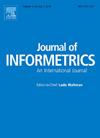科学合作网络结构对影响力和创新的影响:项目团队的视角
IF 3.5
2区 管理学
Q2 COMPUTER SCIENCE, INTERDISCIPLINARY APPLICATIONS
引用次数: 0
摘要
科学合作对于应对复杂的研究挑战至关重要,因此必须优化研究团队的配置。现有研究主要探讨合作网络特征对单篇论文的影响力和创新性的影响,但较少关注研究项目背景下的这些特征。为了弥补这一不足,本研究从项目团队的角度出发,探讨科研合作网络结构对科研成果影响力和创新性的影响。我们采用普通最小二乘回归法和负二项回归法,对包含 21,618 项国家自然科学基金资助及其相关 351,550 篇论文的数据集进行了严格分析,探讨了特定网络特征如何影响研究成果的创新性和影响力。结果显示,结构性漏洞的数量与团队论文的影响力和传统性之间存在负相关。同时,项目团队的小世界与论文的影响力呈正相关,与创新性呈倒 U 型关系。进一步的分析表明,结构洞与小世界之间不存在交互效应。我们还进行了一系列稳健性检验,证明这些结论是稳健的。这项研究为旨在提高研究团队效率的学者、机构和政策制定者提供了宝贵的见解。它强调了网络属性对研究成果的细微影响,通过关注基于项目的团队结构而不是个人论文合作,提供了一个新的视角。本文章由计算机程序翻译,如有差异,请以英文原文为准。
The effects of scientific collaboration network structures on impact and innovation: A perspective from project teams
Scientific collaboration is critical in tackling complex research challenges, necessitating optimized configurations of research teams. While existing research primarily examines the impact of collaboration network characteristics on the impact and innovation of individual papers, there is less focus on these characteristics within the context of research projects. To bridge this gap, this study adopts the perspective of project teams and explores the influence of scientific collaboration network structures on the impact and innovation of research outputs. By employing ordinary least squares regression and negative binomial regression methods on a dataset encompassing 21,618 NSF grants and their associated 351,550 publications, we rigorously analyze how specific network characteristics impact the innovation and impact of the research outputs. The results reveal a negative correlation between the count of structural holes and both the impact and conventionality of the team's papers. Meanwhile, the small world of a project team positively correlates with the papers' impact and displays an inverted U-shaped relationship with innovation. Further analysis confirms that there is no interactive effect between structural holes and small world. A series of robustness checks have been conducted, demonstrating that these findings are robust. This study contributes valuable insights for scholars, institutions, and policymakers aiming to enhance research team effectiveness. It underscores the nuanced impacts of network properties on research outputs, offering a new perspective by focusing on project-based team structures rather than individual paper collaborations.
求助全文
通过发布文献求助,成功后即可免费获取论文全文。
去求助
来源期刊

Journal of Informetrics
Social Sciences-Library and Information Sciences
CiteScore
6.40
自引率
16.20%
发文量
95
期刊介绍:
Journal of Informetrics (JOI) publishes rigorous high-quality research on quantitative aspects of information science. The main focus of the journal is on topics in bibliometrics, scientometrics, webometrics, patentometrics, altmetrics and research evaluation. Contributions studying informetric problems using methods from other quantitative fields, such as mathematics, statistics, computer science, economics and econometrics, and network science, are especially encouraged. JOI publishes both theoretical and empirical work. In general, case studies, for instance a bibliometric analysis focusing on a specific research field or a specific country, are not considered suitable for publication in JOI, unless they contain innovative methodological elements.
 求助内容:
求助内容: 应助结果提醒方式:
应助结果提醒方式:


